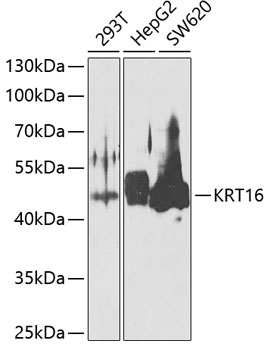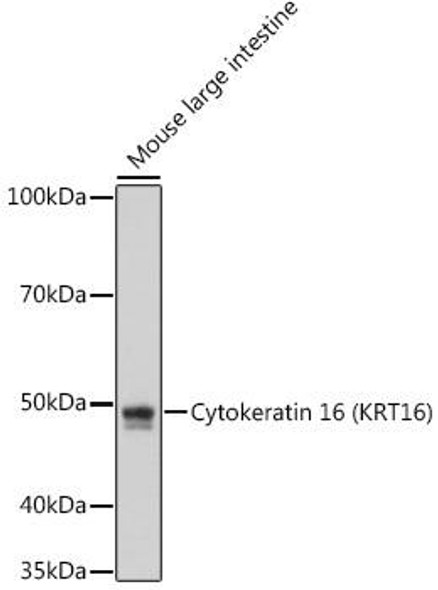Cell Biology Antibodies 11
Anti-KRT16 Antibody (CAB7493)
- SKU:
- CAB7493
- Product Type:
- Antibody
- Reactivity:
- Human
- Reactivity:
- Mouse
- Reactivity:
- Rat
- Host Species:
- Rabbit
- Isotype:
- IgG
- Antibody Type:
- Polyclonal Antibody
- Research Area:
- Cell Biology
Description
| Antibody Name: | Anti-KRT16 Antibody |
| Antibody SKU: | CAB7493 |
| Antibody Size: | 20uL, 50uL, 100uL |
| Application: | WB IF |
| Reactivity: | Human, Mouse, Rat |
| Host Species: | Rabbit |
| Immunogen: | Recombinant fusion protein containing a sequence corresponding to amino acids 190-430 of human KRT16 (NP_005548.2). |
| Application: | WB IF |
| Recommended Dilution: | WB 1:500 - 1:2000 IF 1:50 - 1:200 |
| Reactivity: | Human, Mouse, Rat |
| Positive Samples: | 293T, HepG2, SW620 |
| Immunogen: | Recombinant fusion protein containing a sequence corresponding to amino acids 190-430 of human KRT16 (NP_005548.2). |
| Purification Method: | Affinity purification |
| Storage Buffer: | Store at -20'C. Avoid freeze / thaw cycles. Buffer: PBS with 0.02% sodium azide, 50% glycerol, pH7.3. |
| Isotype: | IgG |
| Sequence: | LQID NARL AADD FRTK YEHE LALR QTVE ADVN GLRR VLDE LTLA RTDL EMQI EGLK EELA YLRK NHEE EMLA LRGQ TGGD VNVE MDAA PGVD LSRI LNEM RDQY EQMA EKNR RDAE TWFL SKTE ELNK EVAS NSEL VQSS RSEV TELR RVLQ GLEI ELQS QLSM KASL ENSL EETK GRYC MQLS QIQG LIGS VEEQ LAQL RCEM EQQS QEYQ ILLD VKTR LEQE IATY RRLL EGED AHLS S |
| Gene ID: | 3868 |
| Uniprot: | P08779 |
| Cellular Location: | |
| Calculated MW: | 51kDa |
| Observed MW: | 47kDa |
| Synonyms: | KRT16, CK16, FNEPPK, K16, K1CP, KRT16A, NEPPK, PC1 |
| Background: | The protein encoded by this gene is a member of the keratin gene family. The keratins are intermediate filament proteins responsible for the structural integrity of epithelial cells and are subdivided into cytokeratins and hair keratins. Most of the type I cytokeratins consist of acidic proteins which are arranged in pairs of heterotypic keratin chains and are clustered in a region of chromosome 17q12-q21. This keratin has been coexpressed with keratin 14 in a number of epithelial tissues, including esophagus, tongue, and hair follicles. Mutations in this gene are associated with type 1 pachyonychia congenita, non-epidermolytic palmoplantar keratoderma and unilateral palmoplantar verrucous nevus. |
| UniProt Protein Function: | K16: a type I cytoskeletal keratin. The keratins are intermediate filament proteins responsible for the structural integrity of epithelial cells and are subdivided into cytokeratins and hair keratins. There are two types of cytoskeletal and microfibrillar keratin: type I (acidic; 40-55 kDa) [K9 to K20] and type II (neutral to basic; 56-70 kDa) [K1 to K8]. Both a basic and an acidic keratin are required for filament assembly. Generally associates with K6. K16 and K17 are coexpressed only in pathological situations such as metaplasias and carcinomas of the uterine cervix and in psoriasis vulgaris. |
| UniProt Protein Details: | Protein type:Cytoskeletal Chromosomal Location of Human Ortholog: 17q21.2 Cellular Component: cytoskeleton; intermediate filament; nucleus Molecular Function:protein binding; structural constituent of cytoskeleton Biological Process: keratinocyte differentiation; cell proliferation; epidermis development; keratinization; morphogenesis of an epithelium; intermediate filament cytoskeleton organization and biogenesis; innate immune response; cytoskeleton organization and biogenesis; inflammatory response; negative regulation of cell migration; keratinocyte migration; hair cycle; aging Disease: Palmoplantar Keratoderma, Nonepidermolytic, Focal; Pachyonychia Congenita 1 |
| NCBI Summary: | The protein encoded by this gene is a member of the keratin gene family. The keratins are intermediate filament proteins responsible for the structural integrity of epithelial cells and are subdivided into cytokeratins and hair keratins. Most of the type I cytokeratins consist of acidic proteins which are arranged in pairs of heterotypic keratin chains and are clustered in a region of chromosome 17q12-q21. This keratin has been coexpressed with keratin 14 in a number of epithelial tissues, including esophagus, tongue, and hair follicles. Mutations in this gene are associated with type 1 pachyonychia congenita, non-epidermolytic palmoplantar keratoderma and unilateral palmoplantar verrucous nevus. [provided by RefSeq, Jul 2008] |
| UniProt Code: | P08779 |
| NCBI GenInfo Identifier: | 23503075 |
| NCBI Gene ID: | 3868 |
| NCBI Accession: | P08779.4 |
| UniProt Secondary Accession: | P08779,P30654, Q16402, Q9UBG8, A8K488, |
| UniProt Related Accession: | P08779 |
| Molecular Weight: | 473 |
| NCBI Full Name: | Keratin, type I cytoskeletal 16 |
| NCBI Synonym Full Names: | keratin 16 |
| NCBI Official Symbol: | KRT16 |
| NCBI Official Synonym Symbols: | K16; PC1; CK16; K1CP; NEPPK; FNEPPK; KRT16A |
| NCBI Protein Information: | keratin, type I cytoskeletal 16; CK-16; keratin-16; cytokeratin 16; cytokeratin-16; focal non-epidermolytic palmoplantar keratoderma |
| UniProt Protein Name: | Keratin, type I cytoskeletal 16 |
| UniProt Synonym Protein Names: | Cytokeratin-16; CK-16; Keratin-16; K16 |
| Protein Family: | Keratin |
| UniProt Gene Name: | KRT16 |
| UniProt Entry Name: | K1C16_HUMAN |
View AllClose







